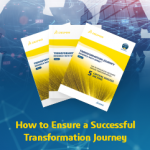The Leader’s 7-Step Guide to a Successful Transformation Journey
Blog: Apriso Blog


Digital Transformation, Industrial Transformation, Smart Manufacturing or Industry 4.0—no matter what you choose to call it, it is undeniable that the modern approach to manufacturing and business is changing. New digital technologies are creating opportunities to drive improved performance, lower manufacturing costs and increase revenue. Companies are pressured to adopt these new innovative operating models to stay competitive, or they risk losing out to faster competitors.
However, successfully executing a digital transformation is not so simple. A survey by McKinsey & Company[1] found that only 16% of companies claim to have had successful digital transformations with sustained improvements. Many companies find themselves in the position where they understand that transformation is necessary, but also risky—and many do not know how to ensure their transformation is a success.
To help companies gain an understanding of what a digital transformation requires, what to consider before undertaking one, and how to drive a successful transformation journey, DELMIA breaks this down into great detail in the Transformation Journey Research Note series.
Step 1: Understanding the 7 Components to Transformation
Transforming manufacturing and operations means deploying 7 components to accelerate improvement across all operations. These are data, data models, analytics tools, control over assets and operations, optimization tools, cloud connectivity, and closed-loop processing. When deployed together effectively, companies can achieve a dynamic operational model that is flexible, resilient and delivers improved performance.
Download Research Note 1 to learn why transformation is so important and explore the details of the 7 technology components.
Step 2: Finding Your Starting Point in the 4-Step Transformation Model
Every transformation journey will have a different area of focus, depending on where each company starts from. Whether companies begin with institutionalized, automated, compressed or optimized processes, each of the 4 stages of transformation maturity will determine a different set of requirements for each company to begin their transformation journey.
Download Research Note 2 to learn about the details of the 4 stages of transformation maturity and discover where your company starts.
Step 3: Key Things to Consider in Planning and Executing Transformation
As necessary as transformation seems today, company leaders would be prudent to recognize that jumping into a transformation program without careful consideration could be a costly mistake. Many companies have failed in their transformation programs before, and to mitigate the risks and raise the probability of success, leaders should take 7 important questions into consideration before starting.
Some examples include:
- How should returns or success be measured?
- Is transformation a top-down initiative?
- Is transformation primarily about technology?
Download Research Note 3 to discover the 7 key considerations in planning and executing your transformation strategy.

DELMIA plays its part in helping company leaders understand the risks, benefits and strategies to execute a successful transformation program.
Step 4: Recognizing the Business Benefits of Transformation
Having understood the 7 technology components and 4 stages of maturity in transformation, leaders also need to recognize the real business benefits associated with each component and maturity stage. Having a clear vision of the benefits that each component brings helps companies to focus on working towards specific improvements and measure their progress towards a successful transformation program.
Download Research Note 4 to explore the breakdown of business benefits according to the different components and stages of transformation.
Step 5: Pay Attention to the 6 People Factors Critical to Success
Having defined what makes up a digital transformation, where you should begin and why your company should undergo a transformation, we also need to explore various key factors that are critical to the success of any transformation journey. There are a large number of factors here that can make or break a transformation program, and these can be divided into three categories: People, Process and Technology.
Download Research Note 5 to discover the 6 People factors critical to transformation success, covering areas such as leadership, talent acquisition and allocation, as well as transforming company culture.
Step 6: Pay Attention to the 6 Process Factors Critical to Success
The next step is to look at important factors surrounding the processes required to execute a transformation program. For process changes to be effective, they need to be institutionalized, embedded across the corporation and tied to the corporate culture.
The Process factors include:
- Regularly communicating measures of progress to the whole company
- Adopting an agile methodology
- Prioritizing the right use cases in your company’s transformation program
Download Research Note 6 to learn about the 6 Process factors critical to transformation success.
Step 7: Pay Attention to the 5 Technology Factors Critical to Success
Lastly, leaders need to look at strategies for deploying technology and digital architecture that will determine the success of the transformation program.
Some key factors here to consider include:
- Having to manage multiple technologies simultaneously
- The benefit of democratizing data
- The importance of deploying a business-centric technology strategy.
Download Research Note 7 to discover the 5 Technology factors critical to transformation success.
By breaking down and analyzing the steps needed for a digital transformation program, DELMIA plays its part in helping company leaders understand the risks, benefits and strategies to execute a successful transformation program. Visit our website to view more resources relating to the Transformation Journey Research Note series, including e-seminars and podcasts.
[1] McKinsey & Company. “Unlocking Success in Digital Transformations.” (October 29, 2018)
Leave a Comment
You must be logged in to post a comment.








